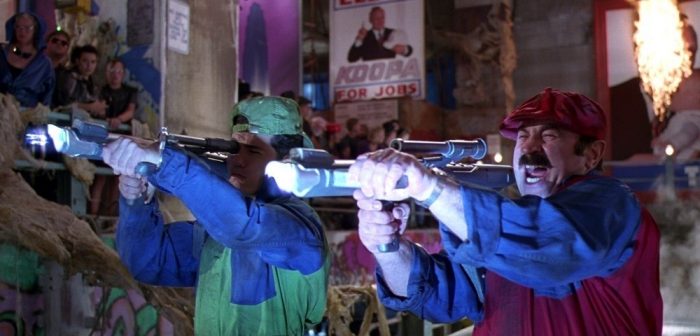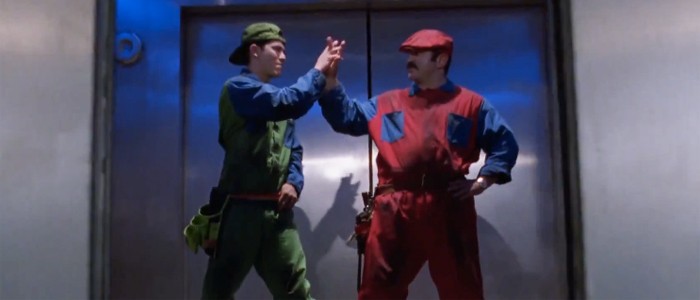
(Welcome to The Unpopular Opinion, a series where a writer goes to the defense of a much-maligned film or sets their sights on a movie seemingly beloved by all. In this edition: Super Mario Bros. is much better than we give it credit for.)
Illumination Entertainment and Nintendo are gearing up to bring Mario, Luigi and the gang back to the big screen with an animated Super Mario Bros. film. Fans of the video game are hoping it’s going to be good, especially since many are trying to erase the original live-action film from their memory. It’s popular in film circles to say 1993’s Super Mario Bros. is atrocious. But I disagree. In fact, I think we’re all undervaluing it.
The film, starring Bob Hoskins and John Leguizamo as Mario and Luigi, two brothers who get trapped in an alternate New York City run by humanoid dinosaurs, is a film that is considered so awesomely bad, that it becomes good. But I think it’s actually good. While there are tonal shifts that don’t make sense and a confused sense of direction, Super Mario Bros. is not the worst film to watch on a lazy Saturday afternoon. Its leads are convincing, its design is thought-provoking, and contrary to popular belief, it actually follows the Nintendo video games much closer than people actually remember. What also makes this a good movie is that it’s a movie fit for film lovers who like learning about how to tell better stories. One of the boons from Super Mario Bros. is, in fact, learning about its mistakes.

What makes Super Mario Bros. fun
When I watched it many years ago, I was highly confused as to why a film would mangle something as simple as a story about two plumber brothers saving a princess. But the film I watched was still engaging and, ultimately, it was fun. Sure, it was weird, but most films from the late 1970s, 1980s and early 1990s were equally weird; Honey, I Shrunk the Kids, RoboCop, Escape from New York, the Terminator series, Howard the Duck, the Back to the Future franchise, and, yes, the Star Wars franchise are just some of the weird films that came out during this time. Some of them were successes and others (like Howard the Duck) weren’t, but they still communicate with Super Mario Bros. in that same late ‘80s, hyper-textural, gritty and endearingly gross way.
As far as acting goes, Hoskins and Leguizamo are still acting their butts off, despite being inebriated for most of the filming process (which you’ll read about later). In fact, their talent shows mightily–if they are still engaging and provoking while drunk, it puts in perspective the sheer amount of their acting skill when they’re actually in tune with their characters.
One of the biggest draws for me while watching it was Hoskins’ presence, to be honest. Who Framed Roger Rabbit was (and still is) one of my favorite films, and seeing him made me think I was in good hands while watching the film. At the time, I thought that if Hoskins was in it, it had to be good!
One of the biggest misconceptions about the film is the idea that Hoskins and Leguizamo are miscast, but I actually don’t think they are. Yes, they don’t match what we think of as Mario and Luigi from the video game, but if anyone had to be cast as a realistic brother plumber pair, then Hoskins and Leguizamo are perfect. In fact, I’d say they’re the strongest parts of the movie and the main reason it’s as beloved as it is today. The opening scenes of them in their Brooklyn apartment were charming and indeed, fun. If we are to just look at the scene as one in a straight-laced comedy, it works; we see the dynamic between Mario and Luigi–Mario’s a gruff father-figure to his younger brother who is obsessed with sci-fi conspiracy theories–and we are ready to join them on their adventure, which stars with a fix-it job gone weird.
In Who Framed Roger Rabbit, Hoskins had the ability to make the unbelievable believable and he continues to make the viewer believe in Super Mario Bros. Despite the wild surroundings and even wilder dino characters, Hoskins’ Mario is grounded in reality, staunchly bringing us along for the ride. Leguizamo shares this quality to keep things relatable and grounded–he made us believe he was a viable drag queen in To Wong Foo Thanks for Everything, Julie Newmar, and he gamely portrayed a glam-rock version of Tybalt in Baz Luhrmann’s Romeo + Juliet. Also, on a much more shallow note, Leguizamo’s good-looking; if he wasn’t often looked over for roles due to Hollywood’s idea of what a “leading man” should look like, Leguizamo would have been another artsy, unconventional heartthrob.
What’s also in the film’s favor is that there are still tons of references to the video game, even though the film looks nothing like it. Bob-ombs, a more realistic dinosaur version of Yoshi, Luigi’s girlfriend Daisy, Toad (turned human for the film), Kuribo’s Shoe (interpreted as the special boots Mario and Luigi wear while in the dinosaur underworld) and Bullet Bills all have roles to play in the film. The film’s brightest moment as a Mario film is how much it utilizes tunnels. The dino world and our world are connected via tunnel, setting up a space that can only be navigated by two plumbers with gumption and an endless set of tools. Mario and Luigi also escape through various tunnels, one of the best scenes showcasing Mario, his girlfriend Daniella (who might actually be a reference to Pauline, Mario’s first love interest and resident Donkey Kong character), and several captured women, sliding on a mattress through an iced-over tunnel.
Last, despite its griminess, there’s astounding dystopian detail in Super Mario Bros. version of New York City. It’s a town that does evoke the dystopian metropolises that littered the 1980s box office, such as the ones in Escape from New York, RoboCop and Blade Runner. If it were in another movie, this version of New York would actually be cool. In fact, much of this film would be cool if only it weren’t a film about Nintendo characters.
The biggest issues with Super Mario Bros. is that it’s a thousand films in one. It’s a brother-duo comedy set in modern day, complete with modern problems such as scrounging up money for rent. Then it’s a sci-fi/fantasy adventure/comedy. Then still, it’s a dystopian fantasy shock horror, complete with body horror elements. Somewhere in all of that, it’s a standard damsel-in-distress story.
No one who paid for a Mario movie wants to see Mario and Luigi talk about how they’re going to pay their month’s rent. They also don’t want to see the characters they know and love, like King Koopa, Toad and the Goombas, inconceivably restructured to resemble nothing of their former selves. But at the same time, I don’t think anyone would be opposed to seeing a fun film about an underground dinosaur metropolis who wants to regain the power they once had before the humans came. The film posits a ridiculous sci-fi/fantasy film that would have been even more awesome if it just kept on message and didn’t have tonal whiplash. It also would help if the film wasn’t a bait-and-switch for the film audiences thought they were going to see–a family film about harmless video game characters.
Continue Reading Revisiting Super Mario Bros. >>
The post 1993’s ‘Super Mario Bros.’ is Far More Interesting Than You Remember appeared first on /Film.
from /Film https://ift.tt/2NdZKOD


0 Comments